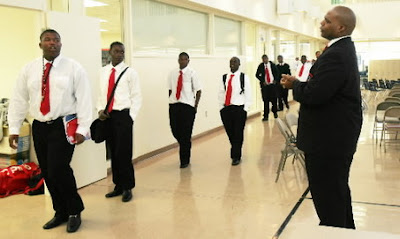I wanted to discuss the things you believe are "innovative in education," just so I might assure you that in this field - in the field of America's future - your administration is doing irreparable harm.
 |
| The "Welsh Not" was hung around the necks of students in Wales who did not conform to the "SLANT" policies of that imperial period. |
Mr. President, this is not innovation. We know this formula. It drove the colonialist education systems of Wales and Ireland in the 18th and 19th centuries. It was the hallmark of British Colonial Schools
It is the well-worn path of imperial cultures. Force those not born "like" the elite to first convert, and then run in a futile attempt to "catch up."
Mr. President, is that what you would want for your daughters?
Acting as an equal human is intolerable in empires - watch from about 4:30 in
The KIPP "SLANT" idea, shown below being introduced by a smug rich guy I cannot identify, is reductionist education which assumes that children of color are incapable of the kind of rich learning available to their wealthy, white counterparts.
White guy spreading his culture to the great "unwashed" oops "challenging"
But let us notice, white kids don't learn that way... whether very young...
Montessori
or older...
St. Ann's in Brooklyn Heights
or older...
Wingra School in Madison, WI
or older...
Scarsdale (NY) High School
President Obama, I believe that every child in this nation deserves the kind of creative, exciting, and culturally open education your children are getting at Sidwell Friends. And I believe that forcing a traditional concept of attention on children in order to make them "white enough" to be unthreatening second-class citizens is wrong on every level.
Let me quote this from the Middle School at Sidwell: "We seek academically talented students of diverse cultural, racial, religious and economic backgrounds. We offer these students a rich and rigorous interdisciplinary curriculum designed to stimulate creative inquiry, intellectual achievement and independent thinking in a world increasingly without borders. We encourage these students to test themselves in athletic competition and to give expression to their artistic abilities. We draw strength from silence—and from the power of individual and collective reflection."
Now let us see how much less KIPP kids get: "KIPP Academy Lynn Charter School will create an environment where the students of Lynn will develop the academic skills, intellectual habits and character traits necessary to maximize their potential in high school, college and the world beyond." "Academic Skills - Calculate accurately - Read fluently - Write effectively - Comprehend fundamental knowledge." "KIPP Academy Lynn will relentlessly focus on high student performance on standardized tests and other objective measures."
What research is it, Mr. President, that Secretary Duncan cites to indicate that the students of KIPP Academy Lynn Charter School deserve so much less - of life, of creativity, of respect, of freedom, than your daughter's classmates at Sidwell?
No Mr. President, KIPP Academies are not innovation. They are the oldest colonialist form of oppression in the school manual. They are institutions of the elite's cultural power, and their purpose is to protect the elites by ensuring that underclass children will never catch up.
But, if you really want to prove me wrong, send your daughters to a KIPP Academy. Your i3 grants mean there should be one coming to the White House neighbourhood soon.
Let me quote this from the Middle School at Sidwell: "We seek academically talented students of diverse cultural, racial, religious and economic backgrounds. We offer these students a rich and rigorous interdisciplinary curriculum designed to stimulate creative inquiry, intellectual achievement and independent thinking in a world increasingly without borders. We encourage these students to test themselves in athletic competition and to give expression to their artistic abilities. We draw strength from silence—and from the power of individual and collective reflection."
Now let us see how much less KIPP kids get: "KIPP Academy Lynn Charter School will create an environment where the students of Lynn will develop the academic skills, intellectual habits and character traits necessary to maximize their potential in high school, college and the world beyond." "Academic Skills - Calculate accurately - Read fluently - Write effectively - Comprehend fundamental knowledge." "KIPP Academy Lynn will relentlessly focus on high student performance on standardized tests and other objective measures."
What research is it, Mr. President, that Secretary Duncan cites to indicate that the students of KIPP Academy Lynn Charter School deserve so much less - of life, of creativity, of respect, of freedom, than your daughter's classmates at Sidwell?
No Mr. President, KIPP Academies are not innovation. They are the oldest colonialist form of oppression in the school manual. They are institutions of the elite's cultural power, and their purpose is to protect the elites by ensuring that underclass children will never catch up.
But, if you really want to prove me wrong, send your daughters to a KIPP Academy. Your i3 grants mean there should be one coming to the White House neighbourhood soon.
- Ira Socol




















